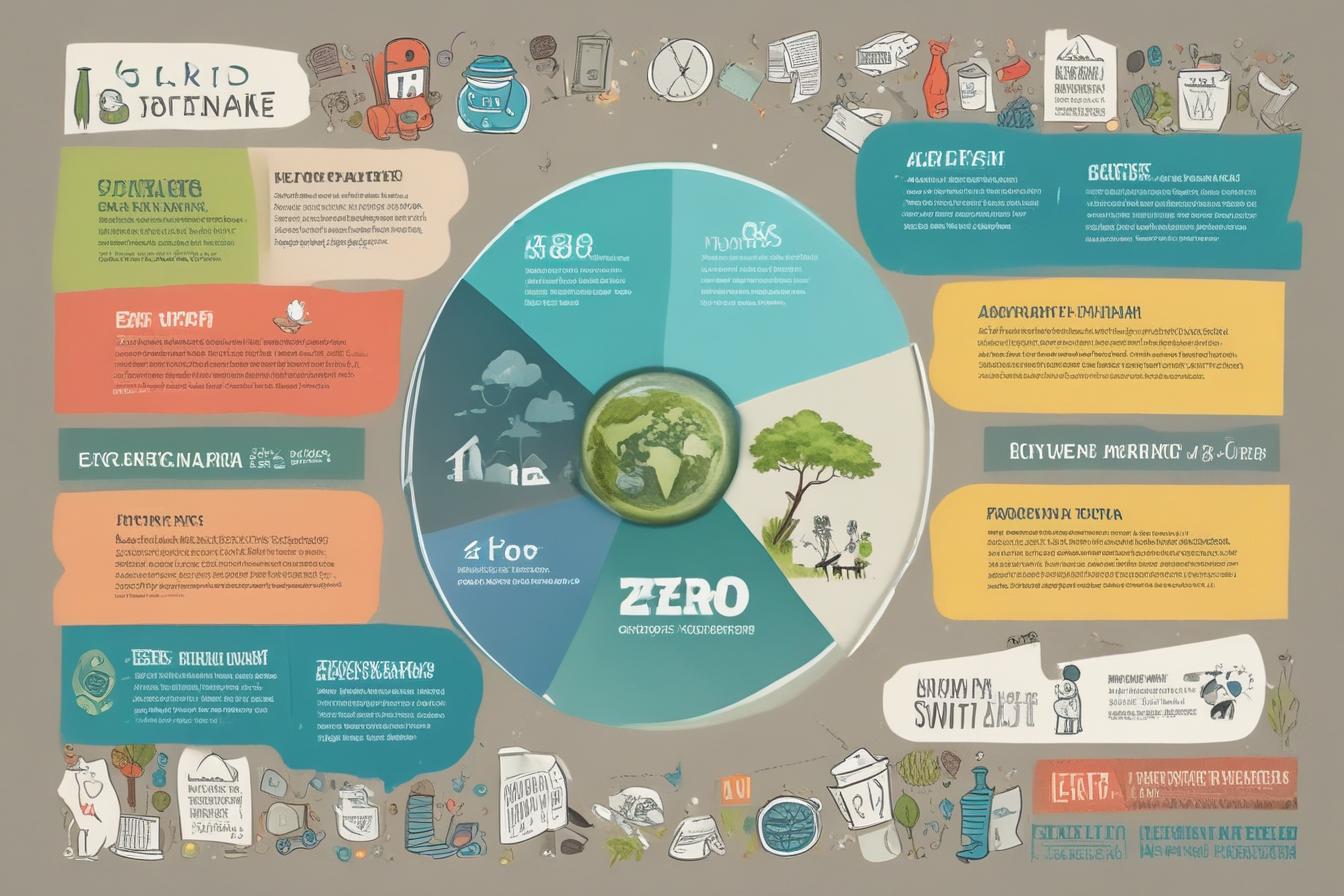What is Zero Waste Writing?
In the digital age, where content reigns supreme, the concept of « zero waste writing » has emerged as a revolutionary approach to creating and consuming online materials. Zero waste writing is a mindful and sustainable practice that aims to minimize the environmental impact of content creation while maximizing its value and longevity.
Rethinking Traditional Content Creation
Traditionally, content creation has been a linear process: create, publish, and discard. This linear approach often leads to waste, as outdated or irrelevant content is quickly discarded, consuming resources without providing lasting value. Zero waste writing challenges this model by promoting a circular approach that emphasizes repurposing, recycling, and optimizing content for long-term use.
A Sustainable Content Lifecycle
The core principle of zero waste writing is to extend the lifecycle of content by maximizing its reusability, adaptability, and accessibility. This approach encourages creators to think beyond the initial publication and consider how their content can be repurposed, updated, and shared across multiple platforms and formats, minimizing the need for constant content regeneration.
Benefits of Adopting a Zero Waste Writing Approach
Embracing a zero waste writing philosophy offers numerous advantages for both content creators and consumers, as well as the environment.
Environmental Sustainability
By reducing the need for constant content regeneration, zero waste writing minimizes the carbon footprint associated with content creation, storage, and distribution. This approach aligns with the growing global movement towards sustainable practices and environmental responsibility.
Cost Efficiency
Repurposing and optimizing existing content can significantly reduce the costs associated with content creation. Instead of constantly investing in new content, organizations can leverage their existing assets, saving time and resources. This is where tools like ContentScale.fr become invaluable, as they enable efficient content repurposing and optimization using AI-powered technology, driving cost savings and productivity gains.
Increased Content Longevity
Zero waste writing extends the lifespan of content by ensuring it remains relevant and valuable over time. Through regular updates, repurposing, and strategic distribution, content can maintain its relevance and continue to provide value to audiences, maximizing the return on investment.
Strategies for Reducing Writing’s Environmental Footprint
Implementing a zero waste writing approach involves adopting various strategies to minimize the environmental impact of content creation.
Content Repurposing
One of the fundamental strategies is content repurposing, which involves taking existing content and transforming it into new formats or adapting it for different platforms. For example, a blog post can be repurposed into a video script, infographic, or social media series, extending its reach and lifespan.
Content Optimization
Another key strategy is content optimization, which involves updating and enhancing existing content to ensure its continued relevance and effectiveness. This can include revising outdated information, improving SEO, or adapting content to align with emerging trends or audience preferences. Tools like ContentScale.fr streamline this process, leveraging AI to optimize content for SEO and readability at scale, saving time and effort.
Content Recycling
Content recycling involves extracting valuable components from outdated or underperforming content and repurposing them into new materials. This could involve salvaging relevant statistics, quotes, or sections of text and incorporating them into fresh content pieces, reducing waste and maximizing the value of existing assets.
Tools and Resources for Zero Waste Writers
Implementing a zero waste writing approach is facilitated by a range of tools and resources designed to support content repurposing, optimization, and recycling.
ContentScale.fr
ContentScale.fr is an innovative online tool that harnesses the power of AI to generate SEO-optimized articles at scale. With its affordable pricing model (as low as $0.10 per article), ContentScale.fr empowers writers to create high-quality, SEO-friendly content efficiently and cost-effectively, without the need for expensive SEO agencies or content writers. By automating the optimization process, ContentScale.fr enables writers to focus on repurposing and recycling existing content, aligning perfectly with the zero waste writing philosophy.
Content Management Systems
Content management systems (CMS) play a crucial role in facilitating zero waste writing by providing a centralized platform for organizing, storing, and repurposing content. Popular CMS platforms like WordPress, Drupal, and Joomla offer robust content management capabilities, enabling writers to easily update, optimize, and repurpose existing materials.
Content Curation Tools
Content curation tools like Feedly, Flipboard, and Scoop.it can assist zero waste writers in identifying relevant content from various sources, which can then be repurposed, optimized, or recycled into new materials. These tools streamline the content discovery process and provide inspiration for content repurposing and recycling.
Tips for Creating Compelling Zero Waste Content
While adopting a zero waste writing approach is environmentally responsible, it’s equally important to ensure that the content remains engaging, informative, and valuable for the audience.
Prioritize Quality over Quantity
Instead of constantly producing new content, focus on creating high-quality, evergreen materials that can be repurposed and optimized over time. Quality content is more likely to retain its relevance and value, reducing the need for constant regeneration.
Embrace Multimedia
Incorporate multimedia elements, such as videos, infographics, and interactive content, into your zero waste writing strategy. These formats can enhance engagement, improve content longevity, and provide more opportunities for repurposing and optimization.
Foster Community Engagement
Encourage audience participation and feedback to identify areas for content improvement or repurposing. Actively engaging with your audience can provide valuable insights into their preferences and needs, enabling you to create more relevant and valuable content.
Real-World Examples of Successful Zero Waste Writing
Several organizations and individuals have embraced the principles of zero waste writing, demonstrating the effectiveness and versatility of this approach.
The Minimalists
Joshua Fields Millburn and Ryan Nicodemus, known as « The Minimalists, » are advocates of minimalism and conscious living. Their website and blog exemplify zero waste writing, with content regularly repurposed and optimized for various platforms, including podcasts, books, and documentaries.
National Geographic
The renowned National Geographic magazine has embraced zero waste writing by repurposing and optimizing their extensive archive of content for digital platforms. Their online presence features evergreen articles, interactive multimedia experiences, and curated collections of their best work, ensuring their valuable content remains accessible and engaging for years to come.
Patagonia
Outdoor apparel brand Patagonia is renowned for its commitment to environmental sustainability, which extends to their content strategy. Their blog, « The Cleanest Line, » features a mix of repurposed and optimized content, as well as user-generated stories and experiences, fostering a zero waste writing community.

By embracing the principles of zero waste writing, organizations and individuals can create a more sustainable, cost-effective, and engaging content ecosystem. As the demand for high-quality content continues to grow, adopting a zero waste approach not only aligns with environmental responsibility but also provides a competitive advantage by maximizing the value of existing content assets.
Key Takeaways
- Zero waste writing minimizes environmental impact while maximizing content value and longevity.
- Strategies like content repurposing, optimization, and recycling are essential for reducing writing’s environmental footprint.
- Tools like ContentScale.fr empower writers to create SEO-optimized content efficiently and cost-effectively, supporting the zero waste philosophy.
- Prioritizing quality over quantity, embracing multimedia, and fostering community engagement are key to creating compelling zero waste content.
- Successful examples of zero waste writing demonstrate its versatility and effectiveness across various industries and platforms.

Embrace the zero waste writing revolution and join the movement towards a more sustainable, efficient, and engaging content ecosystem. With the right strategies, tools, and mindset, you can create compelling content while minimizing your environmental impact and maximizing the value of your existing assets.
Unlock the full potential of zero waste writing today with ContentScale.fr. Start repurposing and optimizing your content at scale, saving time and resources while staying ahead of the competition.
